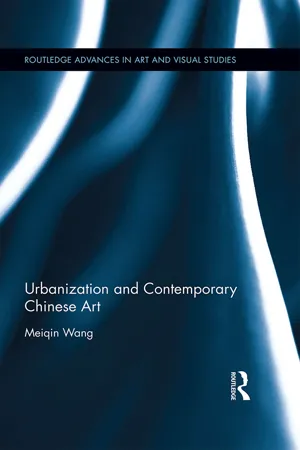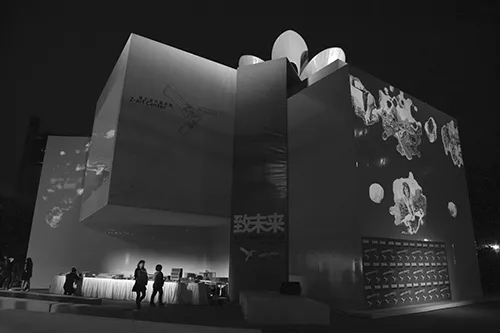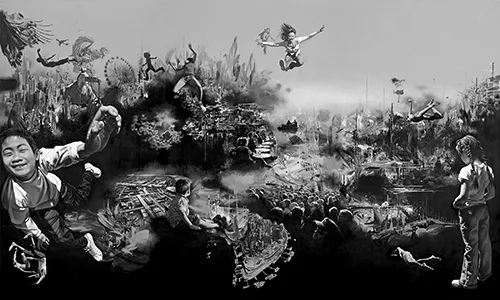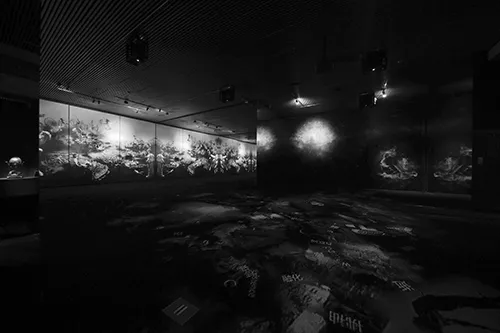The first decade of twenty-first century China is characterized by this ancient and traditionally inward-looking nation’s outspoken ambition to step onto the stage of world affairs and assume a leading position in the future of human society. It does so, among many other things, by actively participating in the competition for global city status and hosting costly mega-international events in its major cities. To realize the lofty and largely state-envisioned goal, national resources have been lavishly spent on many mega events that promise to boost China’s international image and announce its global supremacy.
One such exemplary recent endeavor is the 2010 Shanghai World Expo, touted as the largest, best, and best attended expo in the history of world expos.1 It was also the most expensive expo ever, and like many other Chinese government-led international events such as the recent 2008 Beijing Olympics, it involved massive demolition and frenetic construction throughout the city as Shanghai sought to impress visitors with world-class architecture and a high-standard urban infrastructure. Along the prime banks of Shanghai’s Huangpu River, hundreds of factories and tens of thousands of families were forcibly displaced so 2.5 square miles could be cleared for the construction of a multi-billion dollar World Expo theme park that was scheduled to open on May 1.2 The grievance of these dislocated people was not to be heard within China, since the powerful state propaganda networks had grabbed the nation’s attention with the spectacular aspects of this international event. The hosting of the Shanghai Expo was advocated as a source of national pride and evidence of Shanghai’s status as a world city and a leader of the twenty-first century in technology and innovation.3 Visiting the expo and posing happily for photographs was thus portrayed as a patriotic act, and the Chinese citizens were mobilized or coerced into supporting Shanghai’s goal of hosting a record-breaking expo and cheering for the city’s spectacular rise.4
All of these nationalistic agendas have been played out in the prominent role the city as a political and economic entity has recently assumed in China’s official discourses for modernization and national rejuvenation. The Shanghai Expo clearly announced China’s definite turn towards the city as the site to formulate its new identity for the new century. The theme of the Shanghai Expo was “Better City, Better Life,” which claimed that the city was the engine house for a better life in the future. The official publicity campaign cited American philosopher and urbanist Lewis Mumford’s definition of “city” and proclaimed: “The city is a crystallization of human civilization.”5 New technologies and new design concepts employed in the construction and decoration of many national pavilions were celebrated for demonstrating the leading role the city will play in the future of human society. The Chinese authorities made it clear that, for China, the future is and can only be in the city. The age of the city has arrived, and Shanghai Expo was itself made into an integrated urban spectacle to justify, if not glorify, the sweeping urbanization of China.6
This city dominance is the major sociopolitical environment against which this book examines the recent development of contemporary Chinese art. It delineates the impact of urbanization, with all the exhilaration and destruction, on Chinese art through exploring the relationship between the social-cultural origins of a selective group of artists and the types of artworks they produce in response to the processes of urbanization. This introduction chapter focuses on Zhong Biao, a painter-turned-multimedia artist who has appropriated the prevalence of the spectacle in Chinese cities into the content and methodology of his art making. It posits that the spectacle and in particular the integrated spectacle, propositions formulated by philosopher Guy Debord, have not only been adopted by the Chinese state as a form of social control and public mobilization but has also been employed by the artist for a mixture of purposes such as personal branding, philosophical reflection, social commentary, and artistic reinterpretation.7
1. THE SPECTACULAR FUTURE
On the eve of the Shanghai World Expo, April 30, 2010, at the opening ceremony of his one-man show titled For the Future – Zhong Biao Shanghai 2010, Chongqing artist Zhong Biao presented to his audience a magnificent night gala that went beyond an exhibition opening in the traditional sense. He staged a large-scale site-specific showcase integrating pictorial art, installation, video, audio, and performance arts into an integrated spectacle that centered on the theme “Better City, Better Life,” the very logo of the World Expo. The exhibition venue was the Z-Art Center, a government-funded art museum located in Zhangjiang Hi-Tech Park, one of Shanghai’s earliest and most important economic developmental zones. Zhong was invited by the Center to plan this exhibition in honor of the long-anticipated World Expo and of course to share in the fanfare brought up by this international mega-event.
Under Zhong’s ambitious artistic vision, the entire Z-Art Center was transformed inside and out. The outside of the museum complex was wholly dressed up into a large parcel packed with massive rosy ribbons and was “waiting to be sent to the future,” as stated by Zhong.8
This gigantic parcel for the future was intended to imitate a time capsule by recording the programs of the night gala, both inside and outside of the museum, and the emotional responses from people who were present at this special night. The opening ceremony consisted of a fashion show, holographic film, special music effects, paintings, and antique craftwork, among other items. In the dark gloomy interior of the museum, audiences found themselves greeted by two massive paintings on the walls (the only two in the exhibition), while dazzling holographic images swirled under their feet, hard rock beats and mysterious sounds came from all directions, and multiple ceiling-high mirrors reflected them and everything they saw in the most complex ways.9
The two paintings, each over 4 meters high and 7 meters long, that Zhong exhibited resonated well with the multiplicity of the opening that night. Titled Light Year and To the Future, they presented his philosophical inquiries into time-space matter and his recent deliberation on the origin and tendencies of the phenomenal world. Light Year (2010) is a pictorial representation of the mysterious and boundless universe, in which Zhong attempts to capture the moment of the free forming of energy and life in primordial open space. In the vast and enigmatic cosmos various star constellations shine and star clouds form, and a few human figures begin to take shape. It offers a version of the process in which the human world was created: the birth of human beings and with them human societies and eventually contemporary cities like Shanghai. In Zhong’s rhetoric, “everything is pre-existent, only revealed in the passing of time.”10 He thus indicates his ambition to visualize the permanent existence of energies, motions, and forms in a particular moment and to reveal them on a concrete canvas through his artistic hands.
A more concrete pictorial rendition, To the Future opens with a vast and intertwined aerial view of Shanghai urban scenery, orderly and disorderly, interspersed by recognizable city icons such as the Oriental Pearl Tower and other signature skyscrapers of Shanghai, the Expo venue, and banks of the Huangpu River.
At the same time, it is beyond Shanghai as a specific location fixed in time and space since it contains elements from other cities and other times such as a solitary ancient Chinese scholar—supposedly Confucius, the cityscape of Manhattan, and crowds here and there constituted of people who are not Chinese. No single time, spatial, or geographical logic is present for one to follow in viewing this painting. It is filled with multilayered spatial illusions where various representational images such as people, buildings, boats, etc., intermingle with nonrepresentational forms, abstract brushstrokes, and random drippings of paint. Figures are organized in a very complex scheme: Some are seen from the top, others are seen at eye level, and still others are seen from below. They lie, sit, stand, turn, run, jump, fly, and fall. These disparate forms, shapes, movements, perspectives, spaces, and views, nonetheless, constitute a persuasive reflection of the visual experience of living in an international metropolis such as Shanghai.
The dominant orange tone covering the top half of the canvas, together with the energy expressed by the cavorting figures bathed in bright light, creates a sunny and joyful atmosphere. The pitch-black undertone that sustains the lower half of the canvas and obscures any forms of existence near it, however, suggests secrecy, uncertainty, and even “an estranged state of dangers.”11 This contrast can probably be seen as an indication of the coexistence of apparent prosperity and hidden downsides, both spawned from Shanghai’s rapid ascent into a global city. On the surface, Shanghai has made itself a city of wealth, technology, innovation, and international prestige in less than twenty years and become the home of magnificent skyscrapers, some ranking among the tallest in the world. Under the shadow of Shanghai’s spectacular rise, however, are the widespread urban poverty, inequality, dislocation, and violence that ordinary citizens have to endure.12 Their struggle for a fairer existence in the city is often neglected if not suppressed by powerful political and economic elites, and, as Zhong’s painting indicates, their discontent is subdued in the darkness and nowhere to be found.
In front of the two paintings, the expansive floor of the exhibition room served as the screen for the running of a seven-minute holographic film.
The film starts with a distant cosmic space populated by tiny stars, which is followed by some cosmic eruption, emergence of new forms, and endless flow of objects from our world in an arbitrary and overlapping way; Zhong’s own writing appears in fragmented lines or words; a young girl and boy appear and then fuse into a whirlpool, which then changes to Mandelbrot curls and kaleidoscopic mirrors, only to be replaced by blooming lotus flowers that emerge and disappear again in waves of water; an aerial view of Shanghai appears and then dissolves in its map view, superseded by natural growth and flying birds; the film ends with the city’s map reappearing and melting in the dark cosmos.13 Essentially, this short holographic film, which was played continuously, reinforced the content of the two paintings. Stepping on the ever-moving pictures and running texts on the ground and enshrouded by mysterious metallic music, audiences were immediately permeated by the futuristic visual and sensual experience Zhong intended to evoke, an experience described by the seasoned art curator Gu Zhenqing as a possible way that human beings would communicate with each other in the future.14 The design of the exhibition opening exemplifies Zhong’s typical style of amassing various seemingly disparate elements and somehow achieving an experiential logic, the quality that his two paintings also demonstrate.
Zhong has been known as one of the leading oil painters in contemporary China; he excels in combining his ability to render vivid images with solid painting skills and an acute reflection of the visual charac...



